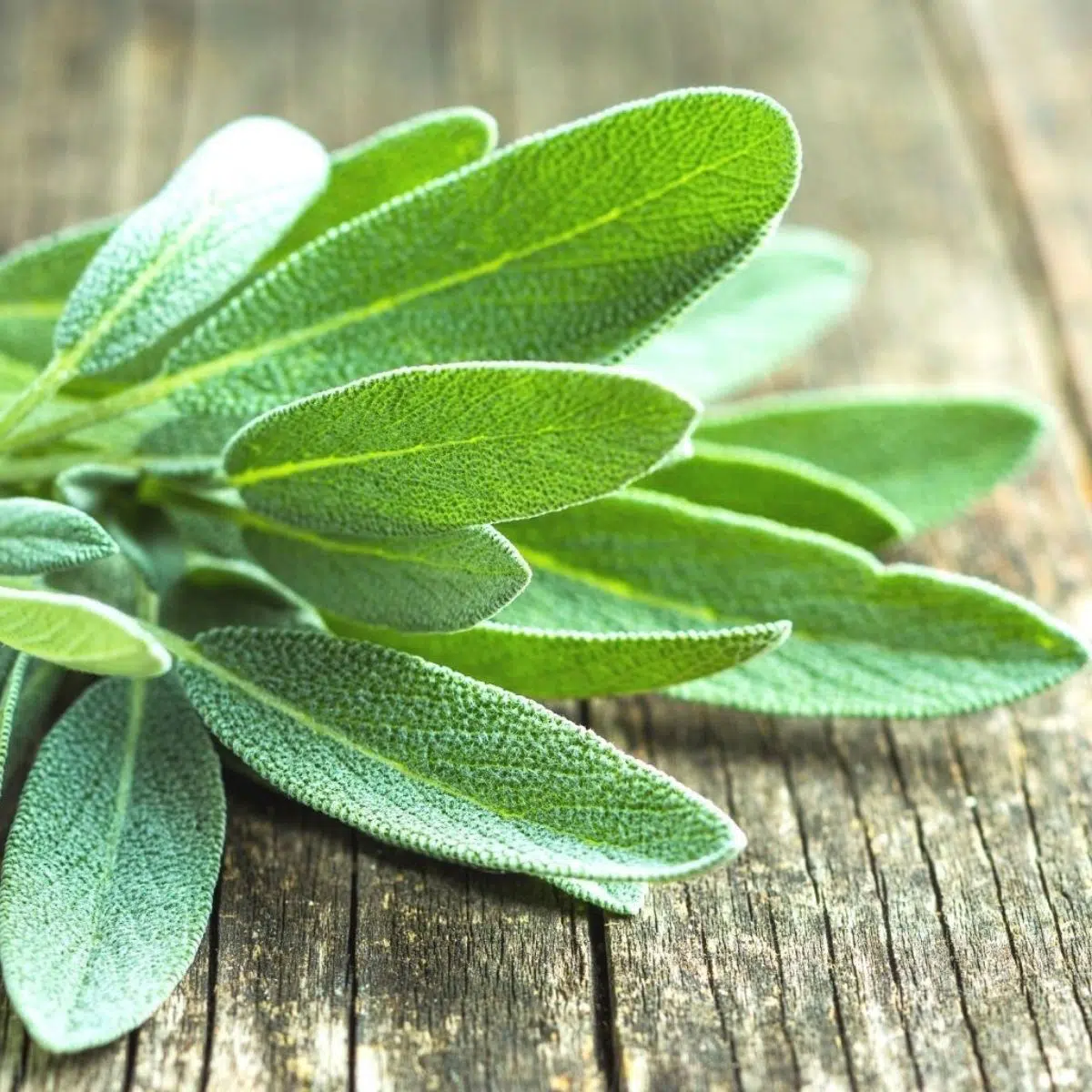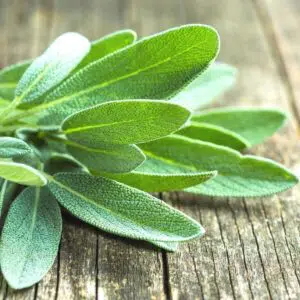The best sage substitute ideas and alternatives, including a variety of different herbs as well as when and how to use them! The earthy taste of sage may seem hard to match, but there are plenty of easy options that will work in any recipe!
Best Sage Alternatives
Sage is an herb that is a member of the mint family. There are several other varietals of herbs in the mint family, including thyme, rosemary, oregano, and mint.
While each of these herbs are part of the same family, they have their own distinct taste. Sage has an earthy taste with hints of pine and citrus. It doesn't have a strong mint flavor; however, some say there are mild notes of it.

Jump to:
The strong earthy notes of sage are one of the reasons that mint is not a recommended substitute. Mint is primarily sweet and peppery, but not earthy. However, many of the other herbs in this family share the earthiness of sage and are great substitutes.
Different Types Of Sage
Most herbs are commonly used in both their fresh and dry form. However, sage is rarely used in its fresh form for cooking. Its dry form comes in two popular forms: rubbed sage or ground sage.
The main difference between rubbed sage and ground sage is their texture. Rubbed sage is dried sage leaves that are loosely broken up. These larger pieces of dried sage are used to rub on meats and root vegetables. Hence the name.
Ground sage is dried sage that has been finely ground. Ground sage is more concentrated than rubbed sage. It can still be used as a rub though. In addition, ground sage is used as a seasoning mixed into a recipe.
Whether using fresh, rubbed, or ground sage, a little bit of sage goes a long way. Therefore, you will find many recipes call for a smaller amount of sage compared to many other herbs.
Best Substitutes For Dried Sage
Since fresh sage is rarely used in cooking, you will likely need a substitute for dried sage. Therefore, it is suggested that you use the dried version of all the substitutes listed below (except for fresh sage).
There are two types of dried sage (rubbed or ground), I opted to write this in regards to substituting for ground sage. This is because ground sage has a stronger flavor than rubbed sage. It is also the more common one to be used in a recipe.
While the ratios suggested are for ground sage, it is easy to adjust for rubbed sage. Since rubbed sage has a milder flavor, start with the suggested ratios, and then add more as needed to taste.
You can also try grinding up rubbed sage to get a more concentrated measurement.
1. Marjoram
When looking for a close flavor substitute, marjoram is a top choice. Although milder than sage, marjoram has similar earthy notes of pine and citrus.
Marjoram goes well with meat, chicken and even pasta. Making it a versatile substitute to use for sage. Marjoram does not retain its flavor as well in the heat though. Therefore, it is best to add it at the end of cooking to help retain the flavor.
Since marjoram is milder than sage you safely use equal amounts as a substitute. If the flavor isn't quite strong enough, slowly add a bit more to taste.
2. Oregano
While marjoram is an easy spice to find in the grocery store, if you have never used it before then you may not have it in your cupboard. In this case, reach for a more common herb - oregano.
Another member of the mint family, oregano has the same earthy flavor profile that sage provides. Although it has less pine and more peppery notes.
It is also used alongside sage in many seasoning blends, especially for Italian cuisine. Therefore, it will offer a similar flavor experience.
Oregano is even stronger than sage when it comes to taste and aroma. Therefore, start by using a ¼ less than the amount that the recipe calls for ¾ teaspoon of oregano for 1 teaspoon of sage.
3. Thyme
Thyme is both another member of the mint family and a common spice to have in your cabinet. It is milder than both sage and oregano though. Therefore, when used as a substitute it won't overpower the other flavors of the dish.
Unlike sage, the earthy flavor of thyme does not hold up well in the heat. To maintain the best flavor when cooking with thyme, add it towards the end of the cooking process.
Use thyme in a simple 1:1 exchange for sage in any recipe.
4. Rosemary
Rosemary made a name for itself in European cuisine. A lovely flavor addition to lamb, poultry, and root vegetables, it is an herb worth adding to your pantry.
Rosemary and sage share similar earthy elements. However, while its name sounds softer than sage, rosemary provides quite a flavor punch.
To avoid overdoing the flavor, use ⅓ the suggested amount when subbing in rosemary: ⅓ teaspoon of rosemary for 1 teaspoon of sage.
5. Tarragon
Unless you are a connoisseur of French cuisine, you may not be familiar with tarragon. Like rosemary though, it is a wonderful herb to get acquainted with. In addition to being a good substitute for sage, its rich earthy flavor is a wonderful way to enrich the flavors of soups, stews, and sauces.
If you are new to tarragon though, be aware that it has strong notes of anise (licorice flavor). Therefore, when used in place of sage it will shift the earthy tones from pine to anise.
While its flavor is a bit different than sage, tarragon can still be used in a simple 1:1 ratio.
6. Basil
Basil is less earthy tasting than sage. Rather, its forward flavors are sweeter and peppery. Although, it does share a hint of mint with sage.
While it is not an exact match for sage, basil and sage are used to compliment many of the same types of dishes. Moreover, they are both used alongside each other in many dishes.
Basil is an easy substitute to use in a 1:1 ratio. It can be used in cooked and cold dishes.
7. Poultry Seasoning
Even though you may be out of sage, you may have a blend with sage in it. Specifically, poultry seasoning.
Poultry seasoning typically includes a blend of sage, thyme, marjoram, and black pepper. While it will not be a straight sage flavor, you can see that it includes several substitutes for sage. Therefore, it will provide a close flavor profile for your recipe.
In addition to being an obvious seasoning for all types of poultry, this seasoning is also a good choice for stuffing. You can also use it as a substitute for sage in breading for poultry or breaded casseroles (similar to stuffing)
Use poultry seasoning in a 1:1 substitution for sage.
8. Savory
While the word "savory" gets used a lot in cooking to describe a flavor, it is actually the name of a specific herb. There are two types of savory: winter and summer.
Both types are closely related to the mint family of herbs. However, they have their own distinct tastes.
Winter savory is an older varietal and has a bolder flavor. Summer savory has brighter notes that are reminiscent of rosemary and thyme. Although, summer savory is a milder overall flavor.
While both winter and summer savory can be used in cooking, summer is the more common type sold and used. It also offers the closest flavor match to sage.
Summer savory can be used in an equal 1:1 ratio for sage. If using winter savory, use half the amount.
Both savory seasonings are best used as a substitute for poultry dishes, including stuffing.
9. Fresh Sage
Fresh sage is not as common to find in the stores as dried sage. If you grow your own sage or come across some, you can use it in place of dried sage.
Fresh sage is quite different than other fresh herbs. While many fresh herbs are lighter, sage has thick leaves that are a bit tough. Make sure you chop the sage up well before using it as a substitute.
Dried sage is more concentrated than fresh sage. Therefore, to achieve the right flavor you will need to use 3x the amount of fresh sage. 1 tablespoon of fresh sage is equal to 1 teaspoon of dried sage.
We hope to have helped you find the perfect sage substitute! Let us know if you found this article useful by commenting below!
Do you love a recipe you tried? Please leave a 5-star 🌟rating in the recipe card below and/or a review in the comments section further down the page.
Stay in touch with me through social media @ Pinterest, Facebook, Instagram, or Twitter! Subscribe to the newsletter today (no spam, I promise)! Don't forget to tag me when you try one of my recipes!
📖 Recipe Card
Best Sage Substitute: Dried Marjoram (+More Great Alternatives!)
Ingredients
Option 1 (Best Matching Flavor) - Marjoram
- 1 teaspoon dried marjoram (add more to taste)
Option 2 (Readily Available Familiar Flavor) - Oregano
- ¾ teaspoon dried oregano
Option 3 (Includes Sage As An Ingredient) - Poultry Seasoning
- 1 teaspoon poultry seasoning
(Note: 2x or 3x only changes the ingredient list)
Instructions
Option 1 (Best Matching Flavor) - Marjoram
- Use dried marjoram in an equal 1:1 ratio to replace ground sage, adding more oregano as needed to taste.
Option 2 (Readily Available Familiar Flavor) - Oregano
- Since dried oregano has a stronger flavor than ground sage, start with ¾ teaspoon to substitute for 1 teaspoon of ground sage in any recipe.
Option 3 (Includes Sage As An Ingredient) - Poultry Seasoning
- Use poultry seasoning in an equal 1:1 ratio for replacing ground sage called for in any recipe.



Comments
No Comments